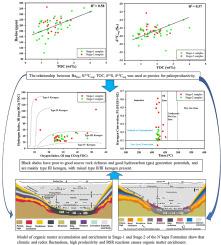Organic matter characteristics in black shales of the southwestern paleogene N'kapa formation, Douala Sub-basin Cameroon: Evidence from stable isotopes and rock-eval pyrolysis
引用次数: 0
Abstract
Shallow marine black shales from outcrops, river channels, drilled and dug wells in Dibombari-Kompina-Mian (Stage-1) and Pendanboko (Stage-2) of the Paleogene N'kapa Formation in Douala Sub-basin were studied. Paleoclimate, paleoredox and paleoproductivity was examined, and the mechanism of organic matter accumulation and enrichment in shales and mudstones of N'kapa Formation was formulated. It provides detailed analysis of organic matter richness and hydrocarbon generation potentials of black shales. The rocks were analyzed using elemental geochemistry, SEM, TOC, organic carbon isotope, sulfur isotopes (pyrite sulfur and organic bound), total sulfur and Rock-Eval pyrolysis. Paleoclimate proxies show that the rocks were deposited under humid to semi-arid conditions. Paleoredox proxies reveal that the sediments were deposited dominantly under suboxic to anoxic conditions. The parameters for paleoproductivity: biogenic barium, δ34Spy, δ13Corg, TOC, Mo/Al, Porg/Al, Cu/Al and S/13Corg ratios indicate that the humid-to semi-arid climate and reducing conditions were suitable for high primary productivity and favorable for the accumulation and enrichment of organic matters. The model of organic matter accumulation reveals that high primary productivity, suboxic-to-dominantly anoxic sulfidic bottom water, bacterial sulfate reduction (BSR) and supply of nutrient materials were responsible for accumulation and preservation of organic matter. The black shales have fair to good source rock richness for gaseous hydrocarbon generation, except for samples KO6-9, KO10-1 and KO13-2 having good gas/oil source rock potentials. The rocks are mainly type III kerogen, with few mixed type II/III kerogens present. Most samples are thermally immature, with three exceptional samples at marginally early mature stage for hydrocarbon generation.

喀麦隆Douala亚盆地西南古近系N’kapa组黑色页岩有机质特征:稳定同位素和岩石热解证据
对杜阿拉次盆地古近系N’kapa组dibomari - kompina - mian(一期)和Pendanboko(二期)的露头、河道、钻井和挖井的浅海黑色页岩进行了研究。考察了古气候、古氧化还原和古生产力,阐述了N’kapa组页岩和泥岩有机质富集机制。详细分析了黑色页岩的有机质丰度和生烃潜力。采用元素地球化学、SEM、TOC、有机碳同位素、硫同位素(黄铁矿硫和有机结合)、总硫和Rock-Eval热解等方法对岩石进行分析。古气候指标表明,这些岩石是在湿润至半干旱的条件下沉积的。古氧化还原指标显示,沉积物主要在缺氧-缺氧条件下沉积。生物源钡、δ34Spy、δ13Corg、TOC、Mo/Al、Porg/Al、Cu/Al和S/13Corg比值等古生产力参数表明,湿润-半干旱气候和还原条件适合于高初级生产力,有利于有机质的聚集富集。有机质积累模式表明,高初级生产力、亚氧至主要缺氧硫化物底水、细菌硫酸盐还原(BSR)和营养物质的供应是有机质积累和保存的主要原因。除KO6-9、KO10-1和KO13-2样品具有良好的油气源岩潜力外,黑色页岩气生烃源岩丰富度一般至较好。岩石以III型干酪根为主,II/III型混合干酪根较少。大多数样品热不成熟,有3个例外样品处于生烃的略早成熟阶段。
本文章由计算机程序翻译,如有差异,请以英文原文为准。
求助全文
约1分钟内获得全文
求助全文

 求助内容:
求助内容: 应助结果提醒方式:
应助结果提醒方式:


